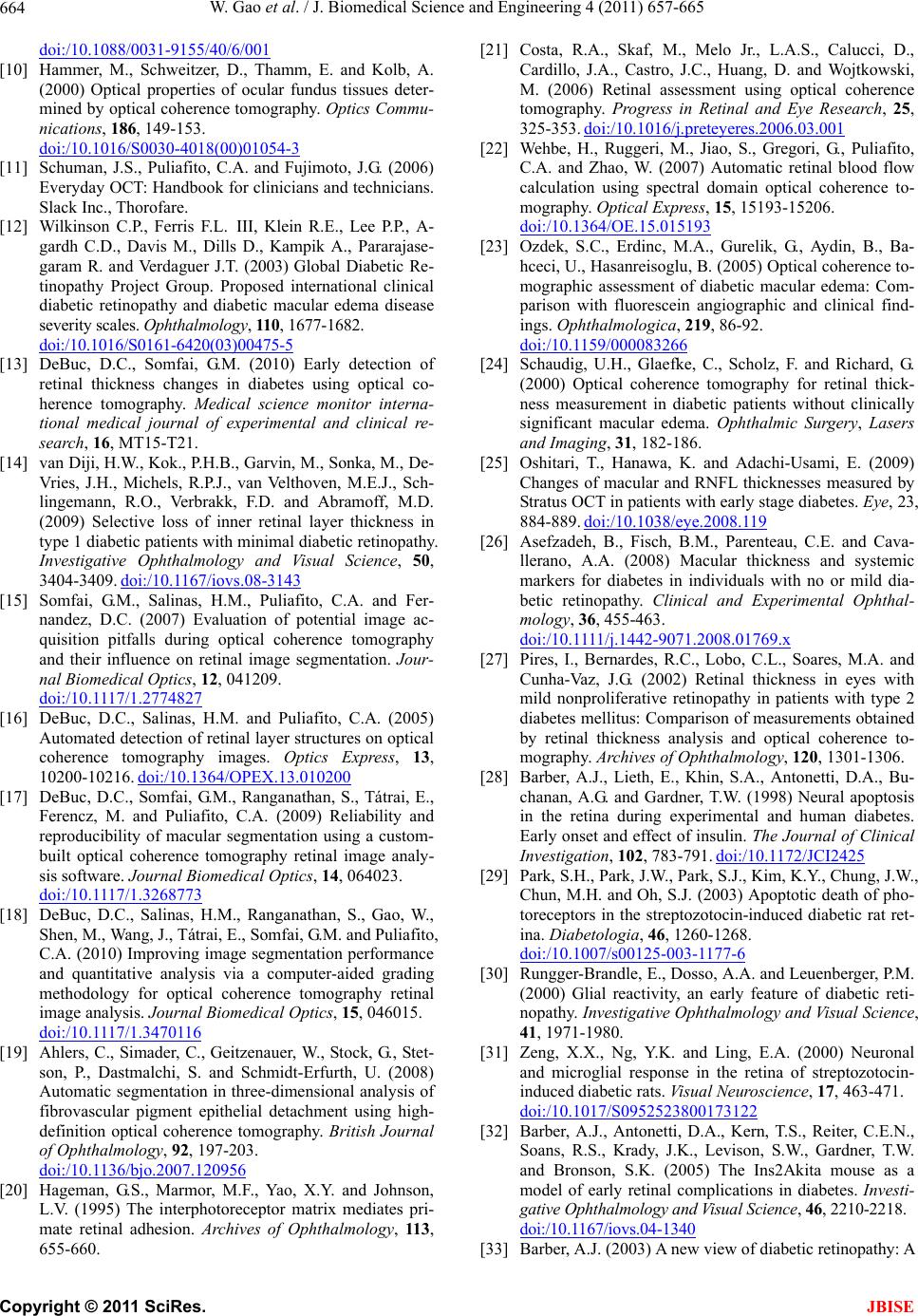
W. Gao et al. / J. Biomedical Science and Engineering 4 (2011) 657-665
664
doi:/10.1088/0031-9155/40/6/001
[10] Hammer, M., Schweitzer, D., Thamm, E. and Kolb, A.
(2000) Optical properties of ocular fundus tissues deter-
mined by optical coherence tomography. Optics Commu-
nications, 186, 149-153.
doi:/10.1016/S0030-4018(00)01054-3
[11] Schuman, J.S., Puliafito, C.A. and Fujimoto, J.G. (2006)
Everyday OCT: Handbook for clinicians and technicians.
Slack Inc., Thorofare.
[12] Wilkinson C.P., Ferris F.L. III, Klein R.E., Lee P.P., A-
gardh C.D., Davis M., Dills D., Kampik A., Pararajase-
garam R. and Verdaguer J.T. (2003) Global Diabetic Re-
tinopathy Project Group. Proposed international clinical
diabetic retinopathy and diabetic macular edema disease
severity scales. Ophthalmology, 110, 1677-1682.
doi:/10.1016/S0161-6420(03)00475-5
[13] DeBuc, D.C., Somfai, G.M. (2010) Early detection of
retinal thickness changes in diabetes using optical co-
herence tomography. Medical science monitor interna-
tional medical journal of experimental and clinical re-
search, 16, MT15-T21.
[14] van Diji, H.W., Kok., P.H.B., Garvin, M., Sonka, M., De-
Vries, J.H., Michels, R.P.J., van Velthoven, M.E.J., Sch-
lingemann, R.O., Verbrakk, F.D. and Abramoff, M.D.
(2009) Selective loss of inner retinal layer thickness in
type 1 diabetic patients with minimal diabetic retinopathy.
Investigative Ophthalmology and Visual Science, 50,
3404-3409. doi:/10.1167/iovs.08-3143
[15] Somfai, G.M., Salinas, H.M., Puliafito, C.A. and Fer-
nandez, D.C. (2007) Evaluation of potential image ac-
quisition pitfalls during optical coherence tomography
and their influence on retinal image segmentation. Jour-
nal Biomedical Optics, 12, 041209.
doi:/10.1117/1.2774827
[16] DeBuc, D.C., Salinas, H.M. and Puliafito, C.A. (2005)
Automated detection of retinal layer structures on optical
coherence tomography images. Optics Express, 13,
10200-10216. doi:/10.1364/OPEX.13.010200
[17] DeBuc, D.C., Somfai, G.M., Ranganathan, S., Tátrai, E.,
Ferencz, M. and Puliafito, C.A. (2009) Reliability and
reproducibility of macular segmentation using a custom-
built optical coherence tomography retinal image analy-
sis software. Journal Biomedical Optics, 14, 064023.
doi:/10.1117/1.3268773
[18] DeBuc, D.C., Salinas, H.M., Ranganathan, S., Gao, W.,
Shen, M., Wang, J., Tátrai, E., Somfai, G.M. and Puliafito,
C.A. (2010) Improving image segmentation performance
and quantitative analysis via a computer-aided grading
methodology for optical coherence tomography retinal
image analysis. Journal Biomedical Optics, 15, 046015.
doi:/10.1117/1.3470116
[19] Ahlers, C., Simader, C., Geitzenauer, W., Stock, G., Stet-
son, P., Dastmalchi, S. and Schmidt-Erfurth, U. (2008)
Automatic segmentation in three-dimensional analysis of
fibrovascular pigment epithelial detachment using high-
definition optical coherence tomography. British Journal
of Ophthalmology, 92, 197-203.
doi:/10.1136/bjo.2007.120956
[20] Hageman, G.S., Marmor, M.F., Yao, X.Y. and Johnson,
L.V. (1995) The interphotoreceptor matrix mediates pri-
mate retinal adhesion. Archives of Ophthalmology, 113,
655-660.
[21] Costa, R.A., Skaf, M., Melo Jr., L.A.S., Calucci, D.,
Cardillo, J.A., Castro, J.C., Huang, D. and Wojtkowski,
M. (2006) Retinal assessment using optical coherence
tomography. Progress in Retinal and Eye Research, 25,
325-353. doi:/10.1016/j.preteyeres.2006.03.001
[22] Wehbe, H., Ruggeri, M., Jiao, S., Gregori, G., Puliafito,
C.A. and Zhao, W. (2007) Automatic retinal blood flow
calculation using spectral domain optical coherence to-
mography. Optical Express, 15, 15193-15206.
doi:/10.1364/OE.15.015193
[23] Ozdek, S.C., Erdinc, M.A., Gurelik, G., Aydin, B., Ba-
hceci, U., Hasanreisoglu, B. (2005) Optical coherence to-
mographic assessment of diabetic macular edema: Com-
parison with fluorescein angiographic and clinical find-
ings. Ophthalmologica, 219, 86-92.
doi:/10.1159/000083266
[24] Schaudig, U.H., Glaefke, C., Scholz, F. and Richard, G.
(2000) Optical coherence tomography for retinal thick-
ness measurement in diabetic patients without clinically
significant macular edema. Ophthalmic Surgery, Lasers
and Imaging, 31, 182-186.
[25] Oshitari, T., Hanawa, K. and Adachi-Usami, E. (2009)
Changes of macular and RNFL thicknesses measured by
Stratus OCT in patients with early stage diabetes. Eye, 23,
884-889. doi:/10.1038/eye.2008.119
[26] Asefzadeh, B., Fisch, B.M., Parenteau, C.E. and Cava-
llerano, A.A. (2008) Macular thickness and systemic
markers for diabetes in individuals with no or mild dia-
betic retinopathy. Clinical and Experimental Ophthal-
mology, 36, 455-463.
doi: /10.1111 /j.14 42 -9071.2008.01769.x
[27] Pires, I., Bernardes, R.C., Lobo, C.L., Soares, M.A. and
Cunha-Vaz, J.G. (2002) Retinal thickness in eyes with
mild nonproliferative retinopathy in patients with type 2
diabetes mellitus: Comparison of measurements obtained
by retinal thickness analysis and optical coherence to-
mography. Archives of Ophthalmology, 120, 1301-1306.
[28] Barber, A.J., Lieth, E., Khin, S.A., Antonetti, D.A., Bu-
chanan, A.G. and Gardner, T.W. (1998) Neural apoptosis
in the retina during experimental and human diabetes.
Early onset and effect of insulin. The Journal of Clinical
Investigation, 102, 783-791. doi:/10.1172/JCI2425
[29] Park, S.H., Park, J.W., Park, S.J., Kim, K.Y., Chung, J.W.,
Chun, M.H. and Oh, S.J. (2003) Apoptotic death of pho-
toreceptors in the streptozotocin-induced diabetic rat ret-
ina. Diabetologia, 46, 1260-1268.
doi:/10.1007/s00125-003-1177-6
[30] Rungger-Brandle, E., Dosso, A.A. and Leuenberger, P.M.
(2000) Glial reactivity, an early feature of diabetic reti-
nopathy. Investigative Ophthalmology and Visual Science,
41, 1971-1980.
[31] Zeng, X.X., Ng, Y.K. and Ling, E.A. (2000) Neuronal
and microglial response in the retina of streptozotocin-
induced diabetic rats. Visual Neuroscience, 17, 463-471.
doi:/10.1017/S0952523800173122
[32] Barber, A.J., Antonetti, D.A., Kern, T.S., Reiter, C.E.N.,
Soans, R.S., Krady, J.K., Levison, S.W., Gardner, T.W.
and Bronson, S.K. (2005) The Ins2Akita mouse as a
model of early retinal complications in diabetes. Investi-
gative Ophthalmology and Visual Science, 46, 2210-2218.
doi:/10.1167/iovs.04-1340
[33] Barber, A.J. (2003) A new view of diabetic retinopathy: A
C
opyright © 2011 SciRes. JBISE